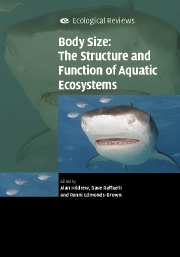Book contents
- Frontmatter
- Contents
- List of contributors
- Preface
- 1 The metabolic theory of ecology and the role of body size in marine and freshwater ecosystems
- 2 Body size and suspension feeding
- 3 Life histories and body size
- 4 Relationship between biomass turnover and body size for stream communities
- 5 Body size in streams: macroinvertebrate community size composition along natural and human-induced environmental gradients
- 6 Body size and predatory interactions in freshwaters: scaling from individuals to communities
- 7 Body size and trophic cascades in lakes
- 8 Body size and scale invariance: multifractals in invertebrate communities
- 9 Body size and biogeography
- 10 By wind, wings or water: body size, dispersal and range size in aquatic invertebrates
- 11 Body size and diversity in marine systems
- 12 Interplay between individual growth and population feedbacks shapes body-size distributions
- 13 The consequences of body size in model microbial ecosystems
- 14 Body size, exploitation and conservation of marine organisms
- 15 How body size mediates the role of animals in nutrient cycling in aquatic ecosystems
- 16 Body sizes in food chains of animal predators and parasites
- 17 Body size in aquatic ecology: important, but not the whole story
- Index
- References
16 - Body sizes in food chains of animal predators and parasites
Published online by Cambridge University Press: 02 December 2009
- Frontmatter
- Contents
- List of contributors
- Preface
- 1 The metabolic theory of ecology and the role of body size in marine and freshwater ecosystems
- 2 Body size and suspension feeding
- 3 Life histories and body size
- 4 Relationship between biomass turnover and body size for stream communities
- 5 Body size in streams: macroinvertebrate community size composition along natural and human-induced environmental gradients
- 6 Body size and predatory interactions in freshwaters: scaling from individuals to communities
- 7 Body size and trophic cascades in lakes
- 8 Body size and scale invariance: multifractals in invertebrate communities
- 9 Body size and biogeography
- 10 By wind, wings or water: body size, dispersal and range size in aquatic invertebrates
- 11 Body size and diversity in marine systems
- 12 Interplay between individual growth and population feedbacks shapes body-size distributions
- 13 The consequences of body size in model microbial ecosystems
- 14 Body size, exploitation and conservation of marine organisms
- 15 How body size mediates the role of animals in nutrient cycling in aquatic ecosystems
- 16 Body sizes in food chains of animal predators and parasites
- 17 Body size in aquatic ecology: important, but not the whole story
- Index
- References
Summary
Introduction
Food chains in which animal predators are bigger than their animal prey are called predator chains; those in which the consumers are smaller are called parasite chains (Elton, 1927; Hutchinson, 1959, p. 147). The purpose of this chapter is to display and test empirically some consequences, for predator chains and parasite chains, of assuming that the average mass of a consumer species (predator or parasite) is related to the average mass of its animal resource species (prey or host) by a power law with an exponent less than 1.
In 1858, as part of his development of the theory of evolution, Wallace (1858, p. 54) noted that animal predators are generally larger and less numerous than their prey. Among the many echoes of Wallace's remark, Elton (1927) observed anecdotally that animal predators weigh more than their prey in terrestrial food chains, Hutchinson (1959) analyzed some of the theoretical consequences of predators weighing more than their prey, and Sheldon, Prakash and Sutcliffe (1972) and others posited that marine animal predators outweigh their marine animal prey (see also Humphries, this volume; Woodward & Warren, this volume). Only recently have body sizes been studied empirically in parasite chains (Memmott, Martinez & Cohen, 2000; Leaper & Huxham, 2002) and parasitoid chains (Cohen et al., 2005). The study of parasitoid chains (e.g. Rott & Godfray, 2000; Memmott et al., 2000) appears not to have been considered by Elton (1927) and Hutchinson (1959).
- Type
- Chapter
- Information
- Body Size: The Structure and Function of Aquatic Ecosystems , pp. 306 - 325Publisher: Cambridge University PressPrint publication year: 2007
References
- 2
- Cited by



